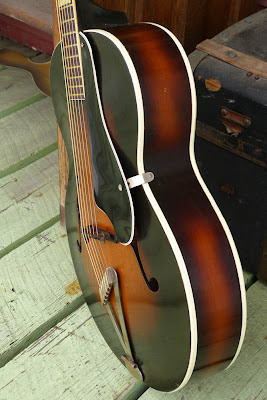c.1952 Gretsch Synchromatic Model 100 Archtop Guitar
This 16" wide acoustic archtop was made by Gretsch in '52 (per the ink serial on the back of the guitar) and bears the "Synchromatic" model script at the headstock. It seems that this model is known as both the "6014" and also "100F" from browsing online. It's a very cool guitar and definitely has a stylish appeal all its own.
I worked on this for a customer of mine and now it's going to be up for grabs as a consignment. Previously he'd had it worked on but the job wasn't really ever finished. This guitar had received a workmanly (but not-very-clean) neck reset in the past but came to me needing the whole neckblock area reglued at the seams, the fretboard extension reprofiled and reglued, the bridge refitted to the top a little better, and the frets leveled and dressed. All that's been done as well as the usual cleaning and setup -- and -- she plays like a breeze!
The tone is rumbly and punchy with a lot of volume and most of the sound focused solidly in the midrange.
The body is entirely laminate which makes this a very durable/practical instrument for gigging with. It's bound on the top, back, and fretboard with white plastic.
Super-cool headstock veneer with gold-sparkle-ish inlset Gretsch and Synchromatic logos. Original bone nut.
Original brass frets in a rosewood board. The big-block inlay is celluloid ("faux-pearl") material.
I love the deco-looking bridges on these guys. This one is rosewood with brass adjusters.
Note that the finish has crackled and weather-checked all over. This is not a pristine finish but it does have a nice aged look to it. It's "friendly."
The big honking Gretsch tailpiece is so cool!
There's some serious finish crackle/checking on the back.
Here's that not-so-cleanly reset neck. The job is good and workmanly but some steam must have escaped the fellow doing the reset since the finish is marred right at the edges of the joint.
Original covered Kluson tuners.
I drop-filled and clamped this small hairline crack and also used the tuner plate that runs over it as a "mending plate" across it by installing two additional tiny screws, one on either side of the crack to keep it stable.
Again, there's that way-cool tailpiece!

















Comments